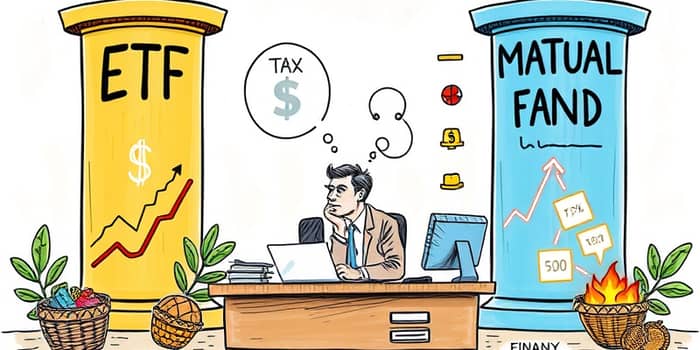
In an era of rapidly shifting markets and evolving investor goals, understanding the tools at your disposal is more important than ever. Exchange-traded funds (ETFs) and mutual funds both promise diversified exposure, yet their mechanics, costs, and tax treatments differ in ways that can impact your long-term returns.
This article provides a thorough, data-driven comparison of ETFs and mutual funds, guiding you toward informed decisions and empowering you to build a resilient portfolio that aligns with your financial vision.
At their core, both ETFs and mutual funds pool capital from many investors to purchase a diversified basket of securities. This powerful tool for portfolio diversification shields you from the risks of individual stocks while offering access to various asset classes—equities, bonds, commodities, and more.
ETFs trade on stock exchanges throughout the day, with real-time pricing and order types such as market, limit, or stop orders. Mutual funds, by contrast, calculate a single net asset value (NAV) at the end of each trading day, with orders executed at that closing price.
Despite surface similarities, the structural nuances of ETFs and mutual funds drive distinct investor experiences. ETFs employ an “in-kind” creation and redemption process, swapping securities for ETF shares. Mutual funds issue or redeem shares directly for cash, often triggering internal capital gains events.
The following table outlines key contrasts in mechanics, pricing, and transparency:
Costs can erode long-term performance, making fee analysis critical. On average, index equity ETFs charge lower expense ratios and cost structure—around 0.14%—compared to 0.40% for equity mutual funds in 2024. Active funds are even pricier, with averages near 0.89%.
Beyond expense ratios, additional charges may apply. ETFs typically avoid load fees but may incur trading commissions if your brokerage does not offer commission-free trades. Mutual funds can levy front-end or back-end load fees of up to 8.5% and ongoing 12b-1 fees up to 1%.
ETFs hold a distinct advantage in tax management. Through in-kind creations and redemptions, an ETF can exchange securities for shares without selling holdings, minimizing capital gain distributions to shareholders. This results in fewer unexpected taxable events within the fund.
Mutual funds, however, often distribute realized gains annually, creating tax liabilities even for investors who make no trades. Transparency also differs: ETFs disclose their full holdings daily, whereas mutual funds typically report holdings quarterly or semiannually.
Leveraging both ETFs and mutual funds can lead to a balanced, diversified strategy. ETFs excel in cost-sensitive, tax-aware allocations, while mutual funds shine when automated contributions and fractional share reinvestments are priorities.
Mixing these vehicles allows you to tailor allocations, combining intraday trading flexibility with the convenience of automatic dollar-cost averaging.
Your choice ultimately hinges on investment objectives, time horizon, and personal preferences. Consider the following:
For active traders or high-net-worth investors, ETFs may offer the highest levels of daily liquidity and control. For regular savers and retirees, mutual funds can provide straightforward access and automated reinvestment features.
ETFs and mutual funds each bring unique strengths to your investment arsenal. By weighing structure, costs, tax implications, and convenience, you can align your holdings with both market realities and personal goals.
Ultimately, a thoughtfully diversified portfolio—blending the best attributes of both vehicles—positions you to navigate market cycles with confidence and clarity, turning complexity into opportunity.
References













